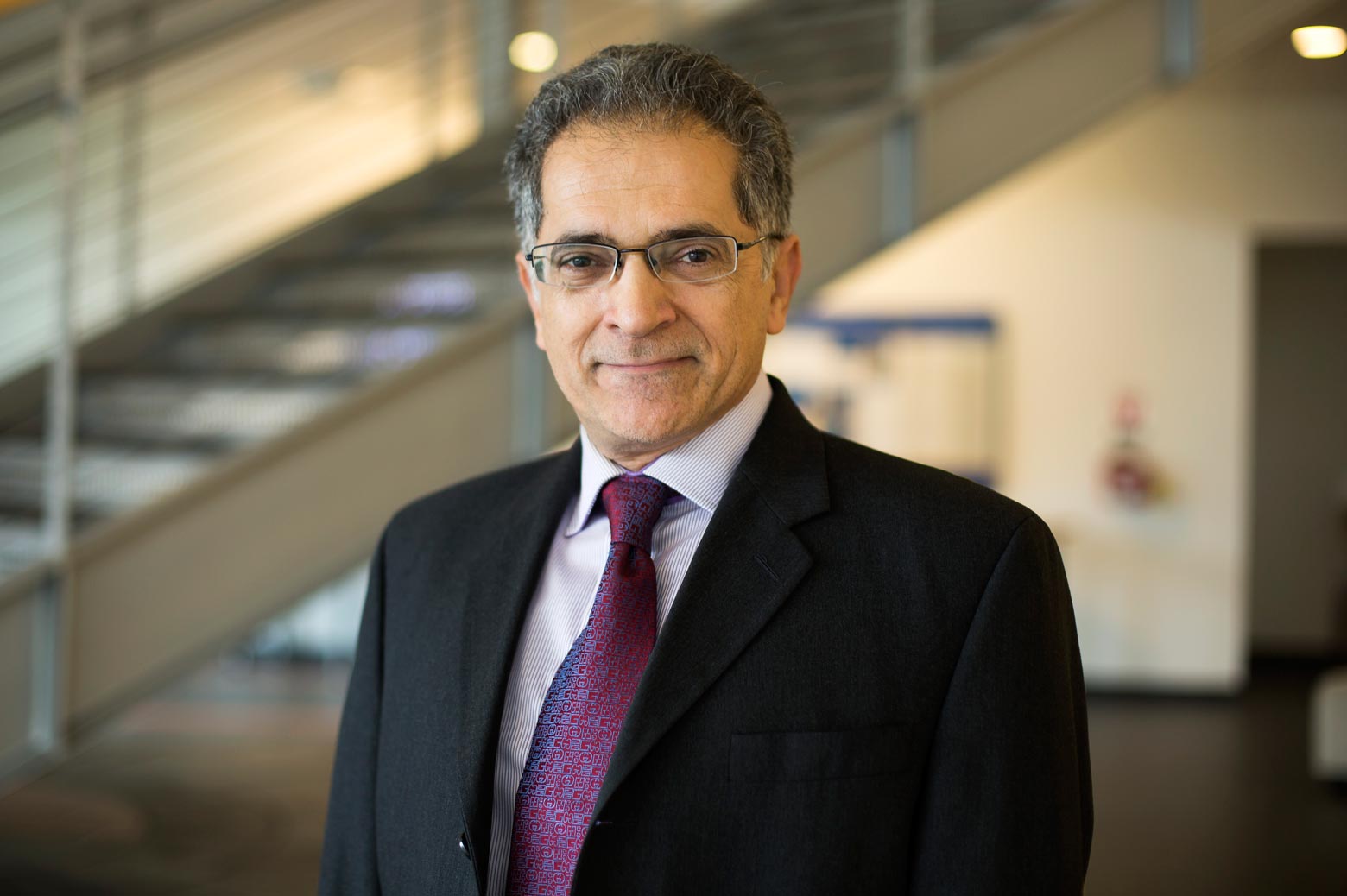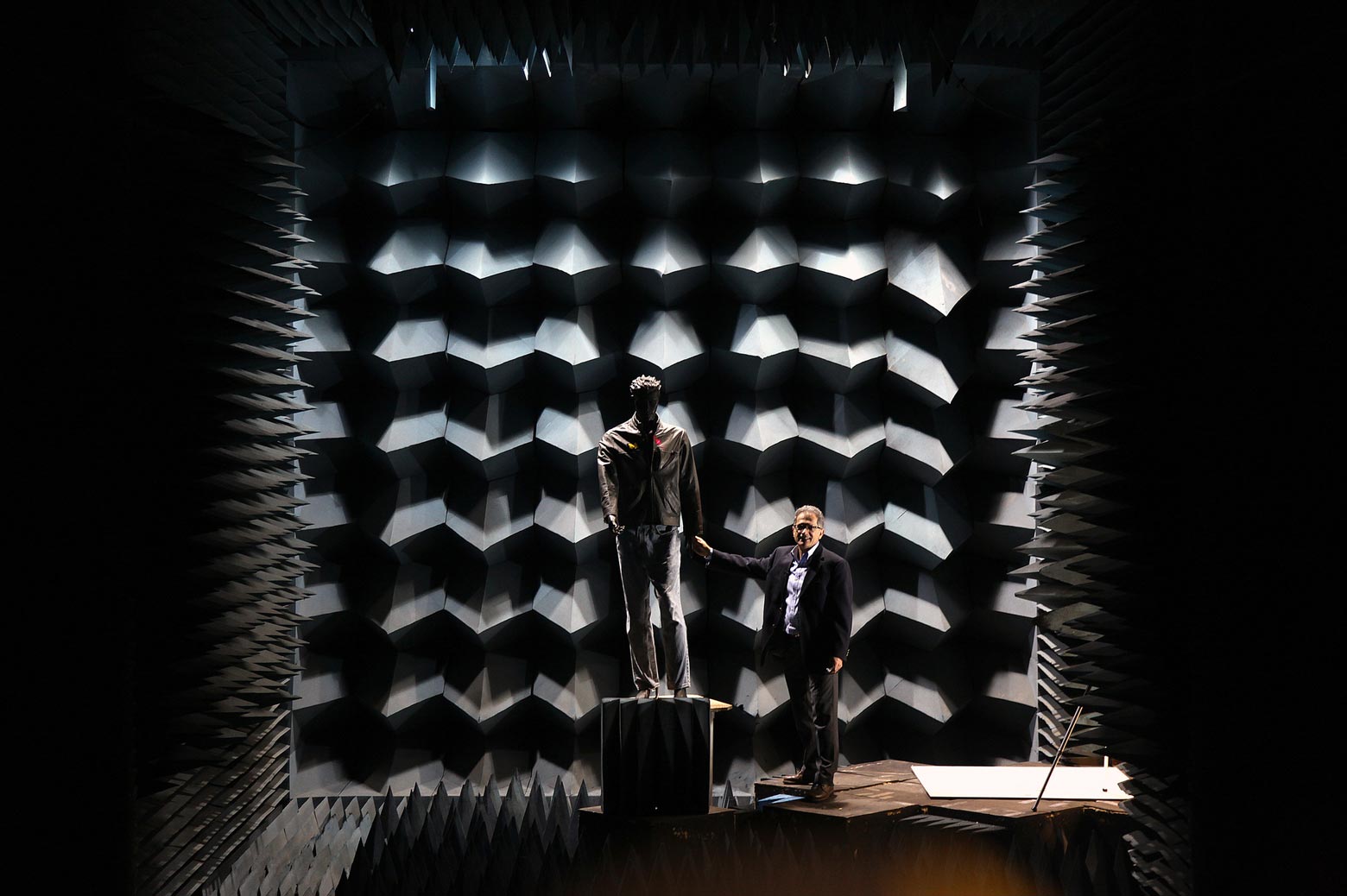The million foot view
Kamal Sarabandi has expanded radar capabilities in applications ranging from low earth orbit to thousands of feet underground.

 Enlarge
Enlarge
“When you see so much, especially at very young age, it broadens your view, it points you to fact of how temporary we are, and how well you have to use your time,” said Kamal Sarabandi, the Rufus S. Teesdale Professor of Engineering.
A fellow of the American Association for the Advancement of Science, who has been repeatedly recognized for his excellence in teaching and service at the University of Michigan, Sarabandi has built a career on seeing through obstacles and monitoring the earth from space. But his long view goes beyond the technical, calibrating his work to have an impact on his field and on society.
He was in the middle of his undergraduate degree at Sharif University of Technology in Tehran when Iran underwent a revolution overthrowing the monarchy and establishing an Islamic Republic. Hopeful about what this could mean for progress in Iran, Sarabandi was one of the peaceful demonstrators marching in the street.
But his real passion was electrical engineering. It first sparked his interest at the age of 10, when a friend’s uncle – an electrical engineer – explained that there was an imperceptible delay between the time he flipped a light switch and the time that the current reached the light bulb. The physics fascinated him and still does, but pure science wasn’t enough. He wanted to do something with it.
After he graduated in 1980, Iran was attacked by Iraq, and Sarabandi was drafted into the military. His expertise kept him off the battlefield and introduced him to the cutting edge of his future field of research.
“I would see the radar systems – these were high-power military radars, communication systems, air defense. You know really cool stuff!” he said with a laugh.
Sarabandi’s expertise enabled him to repair radar systems, but he wanted to understand them more deeply and push their capabilities further. When he was released from service in 1983, he set his sights on graduate school. But the future of universities in Iran was uncertain, just coming out of the three-year closures during the Cultural Revolution. Sarabandi decided to look elsewhere.
Arriving at U-M
Because of the sanctions on Iran, he couldn’t take the usual entrance exams required by U.S. universities such as the Graduate Record Examination or the Test of English as a Foreign Language. Fortunately, at the time, U-M didn’t require them. Sarabandi sent his application to a friend who was already at the university, who hand-delivered it to the admissions office.
Once accepted, he had to find a U.S. embassy – those in Iran were closed in the wake of the hostage crisis. Sarabandi left his fiancé behind and traveled to Hamburg, Germany to file for a visa, staying 40 days there with his uncle before he finally was allowed into the US in February of 1984. Too late for the spring term, he studied English, read up on electrical engineering and waited for fall.

 Enlarge
Enlarge
“The first semester was a little bit tough. I was taking it maybe a bit too seriously,” said Sarabandi.
But his exam score set him apart from his peers, and he was offered a research assistantship. As he entered the research community, he learned that while the public hadn’t yet moved on from concern about the next ice age, the real foreboding was over global warming. Radar was poised to answer questions about how much biomass – forests, crops, grassland and other vegetation – was on the planet and how it was changing as cars and industry put more carbon dioxide into the atmosphere.
In the meantime, his wife-to-be made her own travel arrangements, getting a visa through the embassy in Dubai and travelling to California, where she stayed with relatives. They married in San Francisco in the summer of 1985, and she returned with him to Michigan.
By the time Sarabandi finished his PhD, his wife was in dental school, so he continued on as a research scientist. Then, a faculty position opened up in the Radiation Laboratory in 1992, and he never left. Since 2000, he has served as director of the lab, which is internationally recognized as a top university lab in the field.
Seeing the world through radar
Sarabandi’s work has been wide-ranging, variations on the themes of remote sensing and wireless communications. In addition to biomass, he developed methods to measure soil moisture and snowpack volume. He is currently on the scientific team of NASA’s Soil Moisture Active Passive (SMAP) mission, mapping surface soil moisture across the globe. This information can shed light on the global water cycle and how it changes through the seasons.
Given his achievements in the field, he was chosen to lead the IEEE Geoscience and Remote Sensing Society, the most prestigious international professional society in remote sensing, as its president in 2015 and 2016.
Yet the methods he developed for measuring the natural environment could be translated to urban environments. He extended his expertise to mapping buildings and city blocks, applications that would help first responders and soldiers stay safe.
“All the fundamentals are the same. How does the wave propagate? How does the wave interact with different materials?” said Sarabandi.
As he began his research career, he answered these questions for radio waves encountering leaves, branches, tree trunks and bark – all the way down to the forest floor. And once the electrical properties of these materials were understood, he and his colleagues designed a radar system and algorithms to measure crops and the amount of wood in forests, how much carbon is trapped in plant life. Over time, these landscapes could be reassessed to see how they were changing. Similar radars were deployed on NASA’s Spaceborne Imaging Radar C-band and Shuttle Radar Topography Mission as well as SMAP.
Sarabandi could use radar to make such measurements from space in part because of the advanced mathematical models of radar scattering that he made when he was a research scientist. When radio waves reflect from an object, they are affected by its size, shape and electrical properties. What’s more, if the radar sends out waves in all different polarizations – meaning the waves’ electric fields are oriented differently in space – the waves will see different effects.
Interpreting the data from waves in so many orientations was convoluted, but Sarabandi discovered a way to simplify the analysis. His method identified the way that waves in different orientations saw different aspects of the material when reflected from the same object. He also expanded the spectrum of the radar to pick out more variations among materials – similar to seeing in color, Sarabandi explained. Beyond identifying materials, he and his team have used interferometry, a method for measuring lag between waves arriving at different receivers, to reconstruct 3D images.
By applying your knowledge to a slightly different area, there are these low-hanging fruit where you can quickly and immediately make some contribution.
Kamal Sarabandi
These improvements enabled him to see through and measure not just natural materials but also building materials like concrete and drywall. Pivots like that are built into Sarabandi’s career strategy, which he jokingly compares to Communist five-year plans. He sets goals, spends five years pursuing them, and then re-evaluates and adds new goals.
“By applying your knowledge to a slightly different area, there are these low-hanging fruit where you can quickly and immediately make some contribution,” he said.
Miniaturizing radar and taking it underground
One of his most prestigious projects, the Center for Objective Microelectronics and Biomimetic Advanced Technology, designed and built components for small autonomous systems that could carry out reconnaissance and surveillance missions. As director of the $20 million center, funded by the U.S. Army, Sarabandi brought together experts who could design and build small, low-power, complementary sensors for a variety of autonomous airborne and ground robots.
At the close of the project in the summer of 2017, the team demonstrated, for the first time, that a few ground robots and a drone could see through walls and look in any direction. Sarabandi’s contributions also helped robots move around and steer clear of one another using a system he compares to bat echolocation.
“To get close to what these creatures are doing, we had to design a very low-power, light-weight radar system,” said Sarabandi.
The 5-gram radar can map the pathways available inside a building and locate small objects from as much as 600 feet away in spite of fog, smoke, dust, rain or snow.
Recently, Sarabandi and his group have designed a new radar concept that could enable oil and gas companies to track the position of drills for hydraulic fracturing and map the fissures opened up thousands of feet underground by the high-pressure water – spiked with proprietary chemicals – that enable fossil fuels to be extracted.
“These chemicals are very dangerous if they get into aquifers,” he said. “It’s very important, as you are fracking, to map how far from your pipeline the cracks extend.”
In addition to his research, Sarabandi developed two courses – the “Microwave Measurements Laboratory” and the “Theory of Wave Scattering from Rough Surfaces and Random Media.” He has published over a thousand papers and holds fourteen patents with more pending – mostly antennae designed for mobile systems such as satellites, vehicles and compact electronics. Sarabandi is also a professor of electrical engineering and computer science.
 MENU
MENU 
